My Cart
Your Shopping Cart is currently empty. Use Quick Order or Search to quickly add items to your order!
By Leslie G. Hickok, PhD, and Thomas R. Warne, PhD
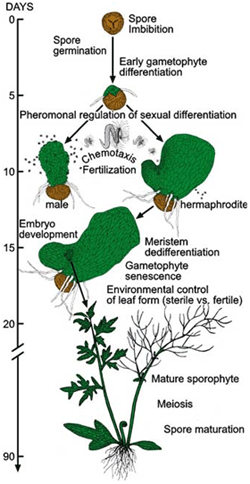
Are your students bored by plants? Often it’s difficult to get them interested in plants because they think that plants are not as naturally interesting or as visually compelling as animals. Nonetheless, plants are an integral and essential component of our living world. Acquiring a basic understanding about plants is a necessary part of any liberal or specialized education experience. Finding better ways to teach about plants is a constant challenge.
Organisms most useful in teaching plant biology are interesting to students, simple to learn and use, easy to grow and manipulate, and applicable to a broad range of disciplines and educational levels. C-FERN®, a specially derived strain of the tropical fern Ceratopteris, has all of these features. It provides a dynamic and economical approach to teaching the principles of plant biology, including the often difficult concept of alternation of generations.
The fern life cycle consists of 2 independent generations: haploid gametophytes and diploid sporophytes (Fig. 1). While living fern sporophytes are readily available for classroom study, the smaller gametophyte generation is often presented merely as a textbook diagram. However, with C-FERN®, both generations can be easily cultured and directly observed by students. C-FERN® culture uses a basic nutrient medium, petri dishes, and a simple culture enclosure. Students need only low-power microscope magnification to observe gametophyte development, the release of swimming sperm, fertilization, and subsequent embryo development.
A key feature of C-FERN® is the rapid development of gametophytes over a 2-week period, which can be easily integrated into classroom instruction (Fig. 1). Under optimum conditions, spores germinate 3 to 4 Days from Starting (DFS) the culture and develop to maturity by 10 to 12 DFS (Fig. 2). The presence of 2 distinct gametophyte sexes, males and hermaphrodites (Fig. 3), provides yet another interesting feature. Control of sexual differentiation does not have a direct genetic basis but depends on the interaction of a chemical signal or pheromone within a developing gametophyte population.
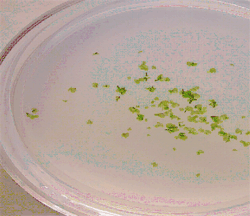 In the absence of this chemical, early germinating gametophytes develop into hermaphrodites that
synthesize and secrete the pheromone. Later germinating gametophytes are affected by the pheromone
and develop into males. These male gametophytes with their many sperm-containing antheridia release
hundreds of swimming sperm when water is added to the culture.
In the absence of this chemical, early germinating gametophytes develop into hermaphrodites that
synthesize and secrete the pheromone. Later germinating gametophytes are affected by the pheromone
and develop into males. These male gametophytes with their many sperm-containing antheridia release
hundreds of swimming sperm when water is added to the culture.
Sperm are attracted to eggs by chemotaxis and form large, active swarms around mature archegonia on hermaphroditic gametophytes. All phases of development, i.e., spore germination, gametophyte growth and differentiation, fertilization, and early embryo development, can be easily observed using a stereomicroscope and/or compound microscope at low-power magnification. Students are often fascinated by this exhibition of plant sexual reproduction with its distinct sexual types and actively swimming sperm that seek out and fertilize receptive eggs. Within a 2-week period students are afforded a dynamic exposure to development of gametophytes from single-celled spores, sexual differentiation, pheromonal control of development and plant sexual reproduction, and alternation of generations.
Many teachers focus on the gametophyte generation and terminate observations when young
sporophytes are evident. However, extended culture and observations of the sporophyte phase
can also be carried out, culminating in the production of h
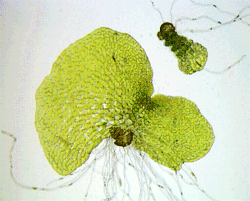 aploid spores to complete the life cycle. While the original C-FERN® can be grown successfully to a mature sporophyte stage
in about 90 days from sowing spores, its large size requires a 2-L plastic container for
each sporophyte.
C-FERN® Express™
is a new strain derived from 2 Japanese varieties of Ceratopteris thalictroides,
developed to improve student investigations through to the fertile sporophyte stage of
the life cycle. In contrast to the original C-FERN®, the smaller C-FERN® Express™
sporophytes can be grown to maturity within the same 60 × 15-mm petri dishes that are
used for gametophyte culture (Fig. 4). And C-FERN® Express™ has a faster life cycle—from
spore to spore in 60 days.
aploid spores to complete the life cycle. While the original C-FERN® can be grown successfully to a mature sporophyte stage
in about 90 days from sowing spores, its large size requires a 2-L plastic container for
each sporophyte.
C-FERN® Express™
is a new strain derived from 2 Japanese varieties of Ceratopteris thalictroides,
developed to improve student investigations through to the fertile sporophyte stage of
the life cycle. In contrast to the original C-FERN®, the smaller C-FERN® Express™
sporophytes can be grown to maturity within the same 60 × 15-mm petri dishes that are
used for gametophyte culture (Fig. 4). And C-FERN® Express™ has a faster life cycle—from
spore to spore in 60 days.
C-FERN® Express™ can be substituted for the wild type C-FERN® strain (RNWT1) in student investigations of the fern life cycle, such as in Carolina’s Sex in a Dish: C-FERN® Life Cycle Kit. Culture requirements for C-FERN® Express™ gametophytes are essentially the same as for the original C-FERN® strain, and all orders for C-FERN® Express™ spores come with an illustrated guide that provides directions for extended culture.
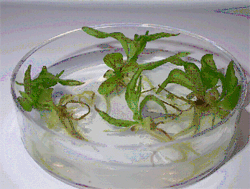
C-FERN® is student and teacher friendly. Because gametophytes and sporophytes are free-living and autotrophic, both can be cultured on simple inorganic media. Easy, foolproof, and student-accessible sterile culture techniques can produce contaminant-free gametophyte cultures; and all stages can be conveniently grown and manipulated with minimal training and equipment.
Getting started can be as easy as boiling water! Premade C-FERN® nutrient agar medium is ready to pour directly into sterile petri dishes after heating in a boiling-water bath. C-FERN® spores are available in presterilized measured units, and cultures can be inoculated by simply adding sterile water and dispensing the spores onto nutrient medium. Larger quantities of unsterilized spores (called bulk-sized) are also available for larger class sizes. After inoculation, the cultures are ready to go under the lights to initiate growth and development. Because the basic medium contains no carbon sources, e.g., sugars, the likelihood of excessive contamination is greatly reduced.
C-FERN® gametophyte cultures are easy to maintain. A simple fluorescent lighting fixture can be used to provide continuous illumination. Also, by keeping cultures in closed C-FERN® Culture Domes (plastic trays with clear covers), distance from the lighting fixture can be adjusted to achieve an optimum temperature of about 28° C (82° F) within the domes. C-FERN® Culture Domes also allow easy handling of many petri dishes, reduce the possibility of contamination, and buffer against changes in room temperature and humidity. A space-saving alternative to the domes is the C-FERN® Growth Pod™, which uses a small insulated container, an acrylic lid, and a 15-W compact fluorescent bulb for light and heat.
The rapid development and small size of gametophytes (0.5 to 3 mm at maturity) enable very large populations of individual plants to be cultured within 60 × 15-mm petri dishes. Cultures of hundreds of gametophytes per petri dish let students observe and work with populations as well as individuals. This provides experience in sampling techniques and statistical treatment of data. Millions of gametophytes can be cultured in very little space, allowing many students to participate.
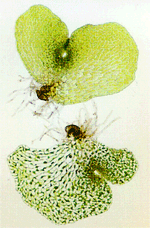
Spores from the wild type and a variety of mutant phenotypes are available. Mutant phenotypes range from striking visual types like ‘polka dot’ (Fig. 5) to developmental mutants like ‘maleless’. Both quantitative and qualitative data sets (e.g., germination rate, population sex ratio, and mutant segregation ratios) can be obtained during the 2- to 3-week culture period, which familiarize students with data acquisition, manipulation, and presentation. The importance of sample size can be demonstrated in exercises using both class and individual data. At the same time, it is possible to manipulate individual gametophytes so that controlled matings, both self- and cross-fertilizations, are easy to accomplish.
C-FERN® is a versatile teaching tool for both hands-on investigations and independent student-initiated research. Separate C-FERN® kits, specifically developed for in-class use, highlight such topics as basic development, nature of sexual differentiation, population interactions, and Mendelian genetics. Since kits are based on the rapid development of the gametophyte generation or include early sporophyte development, exercises can be completed within a 2- to 4-week period and are readily integrated into classroom schedules. The rapid development; simple, inexpensive culture requirements; and easily acquired manipulative techniques also make C-FERN® an exceptionally useful organism for independent research projects. Being able to work with large populations and to closely control experimental conditions helps students design and carry out meaningful projects.
Finding better ways to teach about plants is a constant challenge. C-FERN® can help you meet that challenge. For more information on using C-FERN® in the classroom, and a wealth of other helpful information, visit the C-FERN® Web site. Detailed culture instructions, background material, and other supplemental information are contained in the C-FERN® Manual: Teaching and Research.
Banks, J. A. 1997. Sex determination in the fern Ceratopteris. Trends in Plant Science 2:175.
Chasan, R. 1992. Ceratopteris: A model plant for the 90s. Plant Cell 4:113.
Hickok, L. G., T. R. Warne and R. Fribourg. 1995. The biology of the fern Ceratopteris and its use as a model system. Int. J. Plant Sci. 156:332.
Renzaglia, K. S., T. R. Warne and L.G. Hickok. 1995. Plant development and the fern life cycle using Ceratopteris richardii. Amer. Biol. Teacher 57:438.
Renzaglia, K. S. and T. R. Warne. 1995. Ceratopteris: An ideal model system for teaching plant biology. Int. J. Plant Sci. 156:385.